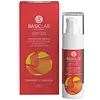What's inside
What's inside
 Key Ingredients
Key Ingredients

 Benefits
Benefits

 Concerns
Concerns

 Ingredients Side-by-side
Ingredients Side-by-side

Water
Skin ConditioningSqualane
EmollientGlycerin
HumectantAscorbyl Tetraisopalmitate
AntioxidantCaprylic/Capric Triglyceride
MaskingTripelargonin
EmollientPolyglyceryl-6 Stearate
EmollientShea Butter Ethyl Esters
EmollientPentylene Glycol
Skin ConditioningPropanediol
SolventSaccharide Isomerate
HumectantCeramide NP
Skin ConditioningRetinol
Skin ConditioningCeramide Ns
Skin ConditioningCeramide AP
Skin ConditioningCholesterol
EmollientTocopherol
AntioxidantCannabidiol - Synthetically Produced
AntioxidantUbiquinone
AntioxidantTrehalose
HumectantBorago Officinalis Seed Oil
EmollientHydroxystearic Acid
CleansingEpilobium Fleischeri Flower/Leaf/Stem Extract
Skin ConditioningScutellaria Baicalensis Root Extract
AstringentHydrolyzed Hyaluronic Acid
HumectantHydrolyzed Sodium Hyaluronate
Skin ConditioningPolysorbate 20
EmulsifyingHydroxyacetophenone
AntioxidantHydrogenated Lecithin
EmulsifyingXanthan Gum
EmulsifyingPolyglyceryl-6 Behenate
Emulsion StabilisingCitric Acid
BufferingOctyldodecanol
EmollientSodium Citrate
BufferingWater, Squalane, Glycerin, Ascorbyl Tetraisopalmitate, Caprylic/Capric Triglyceride, Tripelargonin, Polyglyceryl-6 Stearate, Shea Butter Ethyl Esters, Pentylene Glycol, Propanediol, Saccharide Isomerate, Ceramide NP, Retinol, Ceramide Ns, Ceramide AP, Cholesterol, Tocopherol, Cannabidiol - Synthetically Produced, Ubiquinone, Trehalose, Borago Officinalis Seed Oil, Hydroxystearic Acid, Epilobium Fleischeri Flower/Leaf/Stem Extract, Scutellaria Baicalensis Root Extract, Hydrolyzed Hyaluronic Acid, Hydrolyzed Sodium Hyaluronate, Polysorbate 20, Hydroxyacetophenone, Hydrogenated Lecithin, Xanthan Gum, Polyglyceryl-6 Behenate, Citric Acid, Octyldodecanol, Sodium Citrate
Water
Skin ConditioningNiacinamide
SmoothingAloe Barbadensis Leaf Juice
Skin ConditioningGlycerin
HumectantPanthenol
Skin ConditioningHydrolyzed Glycosaminoglycans
HumectantSodium Hyaluronate
HumectantHyaluronic Acid
HumectantHydrolyzed Hyaluronic Acid
HumectantSodium Hyaluronate Crosspolymer
HumectantCellulose
AbsorbentHectorite
AbsorbentPropanediol
SolventDehydroacetic Acid
PreservativeBenzyl Glycol
SolventCitric Acid
BufferingBenzyl Alcohol
PerfumingXanthan Gum
EmulsifyingEthylhexylglycerin
Skin ConditioningSodium Benzoate
MaskingRaspberry Ketone
MaskingPotassium Sorbate
PreservativeWater, Niacinamide, Aloe Barbadensis Leaf Juice, Glycerin, Panthenol, Hydrolyzed Glycosaminoglycans, Sodium Hyaluronate, Hyaluronic Acid, Hydrolyzed Hyaluronic Acid, Sodium Hyaluronate Crosspolymer, Cellulose, Hectorite, Propanediol, Dehydroacetic Acid, Benzyl Glycol, Citric Acid, Benzyl Alcohol, Xanthan Gum, Ethylhexylglycerin, Sodium Benzoate, Raspberry Ketone, Potassium Sorbate
Ingredients Explained
These ingredients are found in both products.
Ingredients higher up in an ingredient list are typically present in a larger amount.
Citric Acid is an alpha hydroxy acid (AHA) naturally found in citrus fruits like oranges, lemons, and limes.
Like other AHAs, citric acid can exfoliate skin by breaking down the bonds that hold dead skin cells together. This helps reveal smoother and brighter skin underneath.
However, this exfoliating effect only happens at high concentrations (20%) which can be hard to find in cosmetic products.
Due to this, citric acid is usually included in small amounts as a pH adjuster. This helps keep products slightly more acidic and compatible with skin's natural pH.
In skincare formulas, citric acid can:
While it can provide some skin benefits, research shows lactic acid and glycolic acid are generally more effective and less irritating exfoliants.
Most citric acid used in skincare today is made by fermenting sugars (usually from molasses). This synthetic version is identical to the natural citrus form but easier to stabilize and use in formulations.
Read more about some other popular AHA's here:
Learn more about Citric AcidGlycerin is already naturally found in your skin. It helps moisturize and protect your skin.
A study from 2016 found glycerin to be more effective as a humectant than AHAs and hyaluronic acid.
As a humectant, it helps the skin stay hydrated by pulling moisture to your skin. The low molecular weight of glycerin allows it to pull moisture into the deeper layers of your skin.
Hydrated skin improves your skin barrier; Your skin barrier helps protect against irritants and bacteria.
Glycerin has also been found to have antimicrobial and antiviral properties. Due to these properties, glycerin is often used in wound and burn treatments.
In cosmetics, glycerin is usually derived from plants such as soybean or palm. However, it can also be sourced from animals, such as tallow or animal fat.
This ingredient is organic, colorless, odorless, and non-toxic.
Glycerin is the name for this ingredient in American English. British English uses Glycerol/Glycerine.
Learn more about GlycerinHydrolyzed Hyaluronic Acid is a form of hyaluronic acid. It is created by the hydrolysis of hyaluronic acid with a high molecular weight. Once created, Hydrolyzed Hyaluronic Acid has a low molecular weight.
Low molecular weight HA has been shown to hydrate and increase elasticity of the skin. Increasing elasticity is also associated with reduction of wrinkle depth.
One study found topical low molecular weight hyaluronic acid may be considered for the treatment of rosacea in the adult population. However, we always recommend speaking with a professional about your skin concerns.
Hyaluronic acids are a humectant. This means they draw moisture from the air. Hyaluronic acids help moisturize, soothe, and protect the skin.
Read more about other common forms of hyaluronic acid:
Learn more about Hydrolyzed Hyaluronic AcidPropanediol is an all-star ingredient. It softens, hydrates, and smooths the skin.
It’s often used to:
Propanediol is not likely to cause sensitivity and considered safe to use. It is derived from corn or petroleum with a clear color and no scent.
Learn more about PropanediolWater. It's the most common cosmetic ingredient of all. You'll usually see it at the top of ingredient lists, meaning that it makes up the largest part of the product.
So why is it so popular? Water most often acts as a solvent - this means that it helps dissolve other ingredients into the formulation.
You'll also recognize water as that liquid we all need to stay alive. If you see this, drink a glass of water. Stay hydrated!
Learn more about WaterXanthan gum is used as a stabilizer and thickener within cosmetic products. It helps give products a sticky, thick feeling - preventing them from being too runny.
On the technical side of things, xanthan gum is a polysaccharide - a combination consisting of multiple sugar molecules bonded together.
Xanthan gum is a pretty common and great ingredient. It is a natural, non-toxic, non-irritating ingredient that is also commonly used in food products.
Learn more about Xanthan Gum